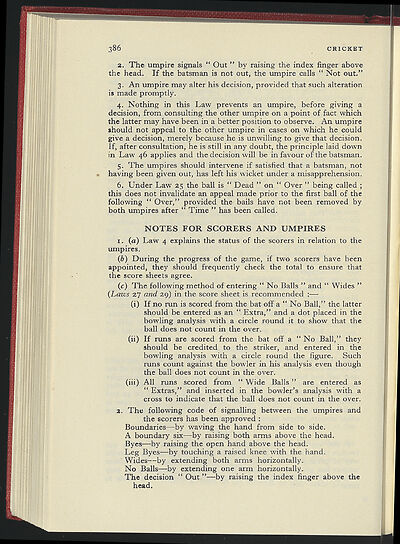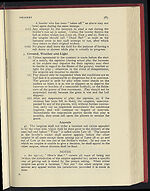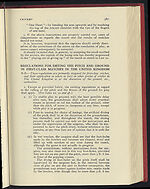1957-58
(404)
Download files
Complete book:
Individual page:
Thumbnail gallery: Grid view | List view

386
CRICKET
2.
The umpire signals " Out " by raising the index finger above
the head. If the batsman is not out, the umpire calls " Not out."
3. An umpire may alter his decision, provided that such alteration
is made promptly.
4. Nothing in this Law prevents an umpire, before giving a
decision, from consulting the other umpire on a point of fact which
the latter may have been in a better position to observe. An umpire
should not appeal to the other umpire in cases on which he could
give a decision, merely because he is unwilling to give that decision.
If, after consultation, he is still in any doubt, the principle laid down
in Law 46 applies and the decision will be in favour of the batsman.
5. The umpires should intervene if satisfied that a batsman, not
having been given out, has left his wicket under a misapprehension.
6. Under Law 25 the ball is " Dead " on " Over " being called;
this does not invalidate an appeal made prior to the first ball
of
the
following " Over," provided the bails have not been removed by
both umpires after " Time " has been called.
NOTES FOR SCORERS AND UMPIRES
I.
(a) Law 4 explains the status of the scorers in relation to the
umpires.
(b) During the progress of the game, if two scorers have been
appointed, they should frequently check the total to ensure that
the score sheets agree.
(c) The following method of entering " No Balls " and " Wides "
(Laws 2'7 and
29)
in the score sheet is recommended
(i) If no run is scored from the bat off a " No Ball," the latter
should be entered as an " Extra," and a dot placed in the
bowling analysis with a circle round it to show that the
ball does not count in the over.
(ii) If runs are scored from the bat off a " No Ball," they
should be credited to the striker, and entered in the
bowling analysis with a circle round the figure. Such
runs count against the bowler in his analysis even though
the ball does not count in the over.
(iii) All runs scored from "Wide Balls" are entered as
Extras," and inserted in the bowler's analysis with a
cross to indicate that the ball does not count in the over.
2.
The following code of signalling between the umpires and
the scorers has been approved :
Boundaries—by waving the hand from side to side.
A boundary six—by raising both arms above the head.
Byes—by raising the open hand above the head.
Leg Byes—by touching a raised knee with the hand.
Wides--by extending both arms horizontally.
No Balls—by extending one arm horizontally.
The decision " Out "—by raising the index finger above the
head.
CRICKET
2.
The umpire signals " Out " by raising the index finger above
the head. If the batsman is not out, the umpire calls " Not out."
3. An umpire may alter his decision, provided that such alteration
is made promptly.
4. Nothing in this Law prevents an umpire, before giving a
decision, from consulting the other umpire on a point of fact which
the latter may have been in a better position to observe. An umpire
should not appeal to the other umpire in cases on which he could
give a decision, merely because he is unwilling to give that decision.
If, after consultation, he is still in any doubt, the principle laid down
in Law 46 applies and the decision will be in favour of the batsman.
5. The umpires should intervene if satisfied that a batsman, not
having been given out, has left his wicket under a misapprehension.
6. Under Law 25 the ball is " Dead " on " Over " being called;
this does not invalidate an appeal made prior to the first ball
of
the
following " Over," provided the bails have not been removed by
both umpires after " Time " has been called.
NOTES FOR SCORERS AND UMPIRES
I.
(a) Law 4 explains the status of the scorers in relation to the
umpires.
(b) During the progress of the game, if two scorers have been
appointed, they should frequently check the total to ensure that
the score sheets agree.
(c) The following method of entering " No Balls " and " Wides "
(Laws 2'7 and
29)
in the score sheet is recommended
(i) If no run is scored from the bat off a " No Ball," the latter
should be entered as an " Extra," and a dot placed in the
bowling analysis with a circle round it to show that the
ball does not count in the over.
(ii) If runs are scored from the bat off a " No Ball," they
should be credited to the striker, and entered in the
bowling analysis with a circle round the figure. Such
runs count against the bowler in his analysis even though
the ball does not count in the over.
(iii) All runs scored from "Wide Balls" are entered as
Extras," and inserted in the bowler's analysis with a
cross to indicate that the ball does not count in the over.
2.
The following code of signalling between the umpires and
the scorers has been approved :
Boundaries—by waving the hand from side to side.
A boundary six—by raising both arms above the head.
Byes—by raising the open hand above the head.
Leg Byes—by touching a raised knee with the hand.
Wides--by extending both arms horizontally.
No Balls—by extending one arm horizontally.
The decision " Out "—by raising the index finger above the
head.
Set display mode to:
![]() Universal Viewer |
Universal Viewer | ![]() Mirador |
Large image | Transcription
Mirador |
Large image | Transcription
| Games and sports in the army > 1957-58 > (404) |
|---|
| Permanent URL | https://digital.nls.uk/248856249 |
|---|
| Description | 'Games and Sports in the Army' was an annual publication produced by the British War Office between the 1930s and 1960s. This included the Second World War. It outlines the rules and regulations for games and sports played by members of the armed forces. It features names and photographs of team members, and examples of contemporary advertising. |
|---|---|
| Shelfmark | GWB.52 |

